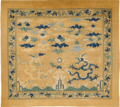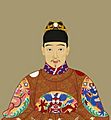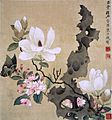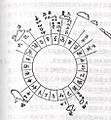Ming dynasty facts for kids
Quick facts for kids
Great Ming
大明
|
|||||||||||
|---|---|---|---|---|---|---|---|---|---|---|---|
| 1368–1644 | |||||||||||
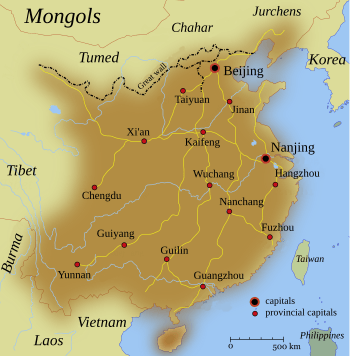
Ming China around 1580
|
|||||||||||
| Capital | Nanjing (Yingtian prefecture) (1368–1644) Beijing (Shuntian prefecture) (1403–1644) |
||||||||||
| Common languages | Official language: Mandarin Other Chinese languages Other languages: Turki (Modern Uyghur), Old Uyghur language, Tibetan, Mongolian, Jurchen, others |
||||||||||
| Religion | Heaven worship, Taoism, Confucianism, Buddhism, Chinese folk religion, Islam, Roman Catholicism | ||||||||||
| Government | Absolute monarchy | ||||||||||
| Emperor (皇帝) | |||||||||||
|
• 1368–1398 (first)
|
Hongwu Emperor | ||||||||||
|
• 1402-1424
|
Yongle Emperor | ||||||||||
|
• 1627–1644 (last)
|
Chongzhen Emperor | ||||||||||
| Senior Grand Secretary | |||||||||||
|
• 1402–1407
|
Xie Jin | ||||||||||
|
• 1644
|
Wei Zaode | ||||||||||
| History | |||||||||||
|
• Established in Nanjing
|
23 January 1368 | ||||||||||
|
• Beijing designated as capital
|
28 October 1420 | ||||||||||
|
• Fall of Beijing
|
25 April 1644 | ||||||||||
|
• End of the Southern Ming
|
1683 | ||||||||||
| Area | |||||||||||
| 1415 | 6,500,000 km2 (2,500,000 sq mi) | ||||||||||
| Population | |||||||||||
|
• 1393
|
65,000,000 | ||||||||||
|
• 1403
|
66,598,337¹ | ||||||||||
|
• 1500
|
125,000,000² | ||||||||||
|
• 1600
|
160,000,000³ | ||||||||||
| Currency | Paper money (1368–1450) Bimetallic: copper cashes (文, wén) in strings of coin and paper Silver taels (兩, liǎng) in sycees and by weight |
||||||||||
|
|||||||||||
| Today part of | |||||||||||
|
Remnants of the Ming dynasty ruled southern China until 1662, and Taiwan until 1683 a dynastic period which is known as the Southern Ming.
¹The numbers are based on estimates made by CJ Peers in Late Imperial Chinese Armies: 1520–1840 ²According to A. G. Frank, ReOrient: global economy in the Asian Age, 1998, p. 109 ³According to A. Maddison, The World Economy Volume 1: A Millennial Perspective Volume 2, 2007, p. 238 |
|||||||||||
The Ming dynasty was a powerful family of emperors who ruled China from 1368 to 1644. This period is also known as the Ming Empire. It lasted for 276 years in Chinese history.
The Ming dynasty is also famous for its beautiful pottery. This pottery came from places like Jingdezhen in Jiangxi and Dehua in Fujian.
Contents
What Does "Ming" Mean?
In Chinese, the Ming dynasty is called Míng (明). This Chinese character is made up of two parts: the sun (日) and the moon (月). Together, they mean "bright".
In English, we use "dynasty" to talk about both the ruling family and the time they ruled. In Chinese, they use different words. The government was called Míng cháo (大明帝國), and the historical period was called Míng dài (明代).
The family name of the Ming emperors was Zhū (朱). This name is a common Chinese family name today. Back then, it also meant a type of red dye made from cinnabar.
The Rise of the Ming Dynasty
How the Ming Dynasty Began
Before the Ming, China was ruled by the Yuan dynasty. The Yuan emperors were Mongols, who were part of the huge Mongol Empire started by Genghis Khan. Most people in China, however, were Han Chinese.
The Yuan rulers tried to use a Chinese style of government. They even used imperial examinations to choose officials. But their laws gave special powers to Mongols. Other groups of people had less power.
Many people in China were unhappy with the Yuan dynasty. In the 1340s, a terrible sickness spread, and the government didn't do enough to fix problems like the Yellow River flooding.
The Red Turban Rebellion
In 1351, a group called the Red Turbans started a rebellion. Their best leader was Zhu Yuanzhang. He was a smart and strong leader. In 1368, Zhu Yuanzhang forced the Yuan emperor, Toghon Temür, to leave the capital city, Khanbaliq (which is now part of Beijing).
When Zhu Yuanzhang took Khanbaliq, he announced that the Yuan dynasty was over. He declared that his family would start a new dynasty called the Ming. He became known as the Hongwu Emperor, and 1368 was the first year of his rule. Even though some Mongols still fought, the Ming became the main government of China.
Hongwu Emperor's Rule
The Hongwu Emperor had many sons. He made them leaders of different parts of China. He moved the capital from Khanbaliq to his old base, Yingtian (which is now Nanjing).
He wanted China to return to its traditional Chinese ways. He stopped most government support for other religions and made Christianity illegal. He also wanted China to be self-reliant, so he largely stopped trade with other countries. He created a set of rules for his family, and they mostly followed these rules throughout the Ming dynasty.
Important Ming Emperors
The Jianwen Emperor and His Uncle
The Hongwu Emperor's oldest son died before him. So, his grandson, the Jianwen Emperor, became the next ruler. The Jianwen Emperor was young, about 20 years old. He didn't like how much power his many uncles had. He started taking away their power and sending them away.
One of his uncles, Zhu Di, was leading the area around Beiping (the old Khanbaliq, now Beijing). Zhu Di pretended to be sick or crazy so that the Jianwen Emperor wouldn't be afraid of him. The emperor even let Zhu Di's three sons, who were kept in the capital as a way to ensure their father's loyalty, go visit him. Soon after, Zhu Di started a war against his nephew.
The Yongle Emperor's Reign
At first, Zhu Di said his war was only against the "bad helpers" who were telling his nephew to hurt their family. But when he won the war and took Yingtian (Nanjing), he made himself the Yongle Emperor. He claimed his nephew had never been the true emperor and punished many people in the old government.
The Yongle Emperor didn't trust the people in Yingtian. So, he made Beiping the main capital city. This southern capital became known as Nanjing, and the northern capital became Beijing, names they still use today. In Beijing, he built a magnificent new home called the Forbidden City.
The Yongle Emperor didn't like many government officials who got their jobs by passing difficult tests. He gave more power to the eunuchs, who were male servants in the palace. One famous eunuch was Zheng He. He was a Muslim who led huge "treasure ships" on seven big trips. These trips sailed south from Suzhou and Nanjing between 1405 and 1433. The first trips might have been to search for the Jianwen Emperor. But they also taught China a lot about the South China Sea and Indian Ocean. These voyages helped open up more trade between China and other countries.
The End of the Ming Dynasty
The Ming dynasty's main capital, Beijing, fell in 1644. A rebellion led by Li Zicheng took over the city. Li Zicheng started his own short-lived Shun dynasty. However, this new dynasty was quickly replaced by the Manchu-led Qing dynasty.
People who still supported the Ming dynasty continued to fight in southern China. This period is known as the Southern Ming. They fought until 1683, when the Ming dynasty finally ended completely.
Why the Ming Dynasty Was Important
The Ming Empire is often called "one of the greatest periods of stable government and social peace in human history." It was the last major Chinese dynasty led by the Han Chinese, who are the main ethnic group in China.
The Ming dynasty is also famous for its beautiful pottery. This pottery came from places like Jingdezhen in Jiangxi and Dehua in Fujian.
Images for kids
-
Portrait of the Hongwu Emperor (r. 1368–98)
-
The Great Wall of China: Most of the brick and stone Great Wall seen today was built during the Ming dynasty.
-
Portrait of the Yongle Emperor (r. 1402–24)
-
The Ming tombs located about 50 km (31 mi) north of Beijing; the site was chosen by Yongle.
-
The Wanli Emperor (r. 1572–1620) in state ceremonial court dress
-
Spring morning in a Han palace, by Qiu Ying (1494–1552); this painting shows the luxury of the late Ming period.
-
Portrait of the Chongzhen Emperor (r. 1627–44)
-
Decorated back of a pipa (a Chinese musical instrument) from the Ming dynasty.
-
Painting of flowers, a butterfly, and rock sculpture by Chen Hongshou (1598–1652).
-
Ming dynasty Xuande period (1426–35) imperial blue and white vase.
-
Wang Yangming (1472–1529), an important Confucian thinker.
-
A Ming dynasty print drawing of Confucius on his way to the Zhou dynasty capital of Luoyang.
-
An illustration showing how iron ore was smelted to make iron, from the Tiangong Kaiwu encyclopedia, 1637.
-
Map of the known world by Zheng He: India at the top, Ceylon at the upper right and East Africa along the bottom.
-
A 24-point compass chart used by Zheng He during his explorations.
-
Portrait of Matteo Ricci by Yu Wenhui, dated 1610.
-
A cannon from the Huolongjing, a book compiled before 1375.
-
The Xuande Emperor (r. 1425–35).
See also
 In Spanish: Dinastía Ming para niños
In Spanish: Dinastía Ming para niños










